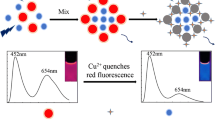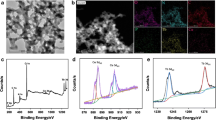Abstract
A ratio fluorescence nanoprobe was constructed by simple mixing BCNO QDs with 8-hydroxyquinoline-5-sulfonic acid (HQSA), which had an obvious fluorescence peak at 420 nm and a weak fluorescence peak at 500 nm, corresponding to the BCNO QDs and HQSA, respectively. This fluorescence probe takes stable fluorescence of BCNO QDs as an internal standard, based on HQSA chelating enhanced fluorescence and specificity of phosphate in the presence of Mg2+, which realizes a rapid and sensitive detection of phosphate with good linearity in the range 0.3–50 μM and 50–100 μM and a detection limit of 0.073 μM. The recovery is between 94.1 and 111% and the relative standard deviations (RSDs) below 10%. At the same time, we took color photos of the reaction solution under 310-nm UV lamp with smartphones for visual detection through RGB data image analysis, which make the detection easier and faster. The proposed method provides a new strategy for the intelligent online detection of other targets in complex environment samples.
Graphical abstract






Similar content being viewed by others
References
Song X, Ma Y, Ge X et al (2017) Europium-based infinite coordination polymernanospheres as an effective fluorescence probe for phosphate sensing. RSC Adv 7:8661–8669. https://doi.org/10.1039/C6RA27819A
Warwick C, Guerreiro A, Soares A et al (2013) Sensing and analysis of soluble phosphates in environmental samples: a review. Biosens. Bioelectron 41:1–11. https://doi.org/10.1016/j.bios.2012.07.012
Sarwar M, Leichner J, Naja G-M et al (2019) Smart-phone, paper-based fluorescent sensor for ultra-low inorganic phosphate detection in environmental samples. Microsyst Nanoeng 5:56. https://doi.org/10.1038/s41378-019-0096-8
Cosnier S, Gondran C, Watelet J-C et al (1998) A bienzyme electrode (alkaline phosphatase polyphenol oxidase) for the amperometric determination of phosphate. Anal Chem 70:3952–3956. https://doi.org/10.1021/ac980125a
Sateanchok S, Pankratova N, Cuartero M et al (2018) In-line seawater phosphate detection with ion-exchange membrane reagent delivery. ACS Sens 3:2455–2462. https://doi.org/10.1021/acssensors.8b01096
Jonca J, Giraud W, Barus C et al (2013) Reagentless and silicate interference free electrochemical phosphate determination in seawater. Electrochim Acta 88:165–169. https://doi.org/10.1016/j.electacta.2012.10.012
Han C, Geng J, Xie X et al (2012) Determination of phosphite in a eutrophic freshwater lake by suppressed conductivity ion chromatography. Environ Sci Technol 46:10667–10674. https://doi.org/10.1021/es300771a
Wang K-P, Zhang S-J, Lv C-D et al (2017) A highly sensitive and selective turn on fluorescent sensor for dihydrogen phosphate in living cells. Sens Actuators B Chem 247:791–796. https://doi.org/10.1016/j.snb.2017.03.052
Yang C, Jing X, Rui Z et al (2013) An efficient Eu-based anion-selective chemosensor:synthesis, sensing properties, and its use for the fabrication of fluorescent hydrogel probe. Sens Actuators B Chem 177:437–444. https://doi.org/10.1016/j.snb.2012.11.065
Tsogas G-Z, Giokas D-L, Vlessidis A-G et al (2016) Flow through fluorescence detection of phosphate in human saliva based on sensitized turn-on photoluminescence of CdS quantum dots. Anal Lett 49:618–626. https://doi.org/10.1080/00032719.2014.979352
Xia Y-S, Wang J-J, Zhang Y-Z et al (2012) Quantum dot based turn-on fluorescent probes for anion sensing. Nanoscale 19:5763–6074. https://doi.org/10.1039/C2NR31809A
Song Y, Li Y, Liu Y-L et al (2015) Highly sensitive and selective detection of phosphate using novel highly photoluminescent water-soluble Mn-doped ZnTe/ZnSe quantum dots. Talanta 144:680–685. https://doi.org/10.1016/j.talanta.2015.07.025
Liu F, Nattestad A, Naficy S et al (2019) Fluorescent carbon and oxygen doped hexagonal boron nitride powders as printing ink for anticounterfeit applications. Adv Opt Mater 7:1901380. https://doi.org/10.1002/adom.201901380
Yang Y-F, Chen J-J, Mao Z-Y et al (2017) Facile synthesis of BCNO yellow-emitting phosphors applications for white leds by microwave heating. Acta Metall Sin-Engl 30:113–119. https://doi.org/10.1007/s40195-016-0495-x
Qi X, Zhang H, Zhu M et al (2016) Hydrothermal synthesis of blue-fluorescent monolayer BN and BCNO quantum dots for bio-imaging probes. RSC Adv 6:79090–79094. https://doi.org/10.1039/C6RA16744F
Zhang J-H, Zhang B, Ren M-X et al (2017) Mechanistic insights into tunable luminescence and persistent luminescence of the full-color-emitting BCNO phosphors. Carbon 122:176–184. https://doi.org/10.1016/j.carbon.2017.06.054
Abdelhamid H-N, Wu H-F (2018) Selective biosensing of Staphylococcus aureus using chitosan quantum dots. Spectrochim Acta A Mol Biomol Spectrosc 188:50–56. https://doi.org/10.1016/j.saa.2017.06.047
Abdelhamid H-N, Chen Z-Y, Wu H-F et al (2017) Surface tuning laser desorption/ionization mass spectrometry (STLDI-MS) for the analysis of small molecules using quantum dots. Anal Bioanal Chem 409(21):4943–4950. https://doi.org/10.1007/s00216-017-0433-4
Wu Z, Zhou Y, Huang H et al (2021) BCNO QDs and ROS synergistic oxidation effect on fluorescence enhancement sensing of tetracycline. Sens Actuators B Chem 332:129530. https://doi.org/10.1016/j.snb.2021.129530
Sun M-F, Liu J-L, Zhou Y et al (2020) High-efficient electrochemiluminescence of BCNO quantum dot equipped boron active sites with unexpected catalysis for ultrasensitive detection of microRNA. Anal Chem 21:14723–14729. https://doi.org/10.1021/acs.analchem.0c03289
Jia X-B, Li L-L, Yu J-J et al (2018) Facile synthesis of BCNO quantum dots with applications for ion detection, chemosensor and fingerprint identification. Spectrochim Acta A 203:214–221. https://doi.org/10.1016/j.saa.2018.05.099
Liu F, Lei T-T, Zhang Y-L et al (2021) A BCNO QDs-MnO2 nanosheets based fluorescence “off-on-off” and colorimetric sensor with smartphone detector for the detection of organophosphorus pesticides. Anal Chim Acta 1184:339026. https://doi.org/10.1016/j.aca.2021.339026
Liu F, Wang M-M, He Y et al (2022) Smartphone-assisted ratiometric fluorescence sensing platform for the detection of doxycycline based on BCNO QDs and calcium ion. Microchim Acta 189:113. https://doi.org/10.1007/s00604-022-05224-6
Renaud R, Alexandre N, Abdelkarim A et al (2015) Development of a direct and continuous phospholipase D assay based on the chelation-enhanced fluorescence property of 8-hydroxyquinoline. Anal Chem 88:666–674. https://doi.org/10.1021/acs.analchem.5b02332
Li S-D, Lu J, Wei M et al (2010) Tris(8-hydroxyquinoline-5-sulfonate) aluminum intercalated Mg-Al layered double hydroxide with blue luminescence by hydrothermal synthesis. Adv Funct Mater 20:2848–2856. https://doi.org/10.1002/adfm.201000200
Lv X-D, Yang J, Fu Y-Q et al (2010) White light emission from Mn2+ doped ZnS nanocrystals through the surface chelating of 8-hydroxyquinoline-5-sulfonic acid. Nanotechnology 21:115702. https://doi.org/10.1088/0957-4484/21/11/115702
Zhang Z-P, Feng J-Y, Huang P-C et al (2019) Ratiometric fluorescent detection of phosphate in human serum with functionalized gold nanoclusters based on chelation enhanced fluorescence. Sens Actuators B Chem 298:126891. https://doi.org/10.1016/j.snb.2019.126891
Shults M-D, Imperiali B (2003) Versatile fluorescence probes of protein kinase activity. J Am Chem Soc 125:14248–14249. https://doi.org/10.1021/ja0380502
Zhang X, Lu Z, Jing L et al (2013) Luminescence properties of BCNO phosphor prepared by a green and simple method. Mater Lett 94:72–75. https://doi.org/10.1016/j.matlet.2012.12.020
Rong M-C, Yang X-H, Huang L-Z et al (2019) Hydrogen peroxide-assisted ultrasonic synthesis of BCNO QDs for anthrax biomarker detection. ACS Appl Mater Interfaces 11:2336–2343. https://doi.org/10.1021/acsami.8b21786
Lei W-W, Portehault D, Dimova R et al (2011) Boron carbon nitride nano-structures from saltmelts: tunable water-soluble phosphors. J Am Chem Soc 133:7121–7127. https://doi.org/10.1021/ja200838c
Liu Q, Jiang P, Pu Z-H et al (2014) BCNO nanoparticles: a novel highly efficient fluorosensor for ultrarapid detection of Cu2+. Sens Actuators B Chem 194:492–497. https://doi.org/10.1016/j.snb.2013.12.121
Zhang X, Yan S, Cheng Y et al (2013) Spectral properties of BCNO phosphor with wide range of excitation and emission. Mater Lett 102–103:102–105. https://doi.org/10.1016/j.matlet.2013.03.124
Racicot J-M, Mako T-L, Olivelli A et al (2020) A paper-based device for ultrasensitive, colorimetric phosphate detection in seawater. Sensors 20:2766. https://doi.org/10.3390/s20102766
Talarico D, Cinti S, Arduini F et al (2015) Phosphate detection through a cost-effective carbon black nanoparticle-modified screen-printed electrode embedded in a continuous flow system. Environ Sci Technol 49:7934–7939. https://doi.org/10.1021/acs.est.5b00218
Funding
This work was financially supported by National Natural Science Foundation of China (21707030 and 82073608).
Author information
Authors and Affiliations
Corresponding authors
Ethics declarations
Conflict of interest
The authors declare no competing interests.
Additional information
Publisher's note
Springer Nature remains neutral with regard to jurisdictional claims in published maps and institutional affiliations.
Supplementary Information
Below is the link to the electronic supplementary material.
Rights and permissions
About this article
Cite this article
Qin, Y., Li, Z., He, Y. et al. Boron carbon oxynitride quantum dots-based ratio fluorescent nanoprobe assisted with smartphone for visualization detection of phosphate. Microchim Acta 189, 238 (2022). https://doi.org/10.1007/s00604-022-05331-4
Received:
Accepted:
Published:
DOI: https://doi.org/10.1007/s00604-022-05331-4




